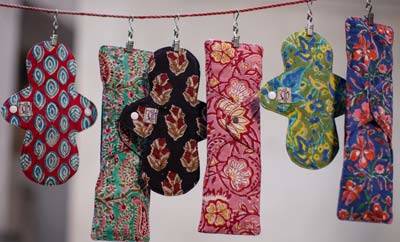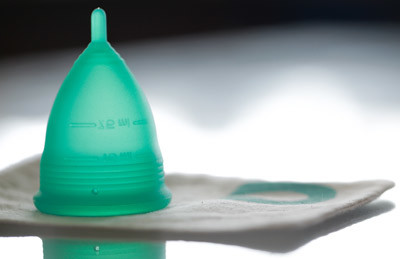Like many girls in India, I was introduced to cloth during my first period. This had to be hand-washed and dried out of sight. I must confess that for my teenage self, the whole idea of cleaning the messy cloth, then disinfecting it to prevent disease, and secretly burning the cloth after it was spent was rather off-putting. So you can imagine my relief when I was finally permitted to use sanitary napkins. These were easily available, and there were so many varieties to choose from—small, large, winged, medium, nightlong ones, the panty liner variety; the gel ones were considered the best. I was in this sanitary napkin heaven—until reality struck.
The problems with commercial sanitary napkins
After switching to commercial sanitary napkins, I noticed that I got frequent rashes around my private parts. It was also hard to ignore the awkward odour in spite of these napkins claiming to be infused with perfume. After use, they had to be wrapped in the provided plastic or an old newspaper and “disposed”.
I lived in a home surrounded by trees and it had its own garbage disposal system—we threw decomposing waste under the trees and the plastics and other non-biodegradable stuff, we either sold to be recycled or burnt it off. The burning was carried out once a week until which time it would be collected in a pit [I now know that that is not the best way of plastic disposal]. As these napkins started gathering in the pit I began to notice that rodents and other creatures (including our pets) would drag them out. Slowly we started finding used napkins almost all over the place. If this was happening in our little piece of land, what was happening outside, I wondered?
I bet everyone living in the city has seen a used sanitary napkin on the streets, being carried by a dog and or a cat or being chewed on by cows. Also, what we so conveniently wrap and throw away has to eventually be handled by conservancy workers, thereby exposing them to health risks. How can this be hygienic, sustainable and healthy?
In the journey of helping patients heal their lifestyle diseases, I have come to understand that, that which harms the environment is always harmful to us. Let’s look at the pros and cons of the conventional pads.
Pros and cons of conventional pads
1. Cotton sanitary pads
Pros
- Easy to use
- Does not need washing
- Easier to decompose as it has no plastic.
Cons
- Has to be thrown away after each use
- May emit foul odour
- Can lead to rashes, sores, discomfort between the thighs
- No guarantee of the quality of cotton being used
- Has to be changed at least thrice a day
- Low absorption capacity
- High risk of spillage and staining
- Needs to be changed in the middle of the night
- Piles up in the garbage
- Difficult to dispose during travel
- Cannot be used while swimming.
2. Gel infused sanitary pads
Pros
- High absorbability
- Lesser staining
- Comes in many shapes and sizes
- Easily available
- Perfumed to mask odour
- Special ones available for night use
- Easy to use
- Easy to dispose during travel.
Cons
- The gels and perfumes can be carcinogenic (cancer causing)
- Plastic components are also carcinogenic and harmful to the environment
- Commonly cause rashes, sores, infections
- Very difficult to decompose—stays on for decades
- Unsightly as it stays for a long time after disposal
- Because of its small size, many end up being thrown in toilets thereby clogging up the drainage system
- Cannot be used during swimming.
3. Tampons
Pros
- Very small as compared to napkins
- Easy to carry and dispose
- Less friction between thighs
- Can be used while swimming
- Travel friendly.
Cons
- Ends up in landfills
- May lead to infection if left in the vagina for long
- Tampons can stick to the vaginal walls, especially when blood flow is light, causing tiny abrasions
- Needs skill to insert
- Plastic, chemicals, pesticides in the tampons are absorbed by the vaginal wall and may cause toxic syndrome
- Can have spills and leakages
- High possibility of pushing into the cavity and causing toxicity, because of the material used.
4. Cloth napkins

Pros
- Easy to use
- Reusable
- Made of skin friendly material like cotton, bamboo etc
- Lesser infections
- Does not end up in the landfill
- Comes with easy instructions on wash and care
- Lesser odour
- Non-allergic and non-carcinogenic.
Cons
- Needs to be washed and dried, which can be cumbersome
- Needs frequent changing
- Cannot be used while swimming
- Not very travel friendly
- High probability of staining and spillage.
5. Menstrual cups

Pros
- Most environment-friendly option
- Does not end up in the landfill
- Various sizes to fit every shape and size
- Made of surgical grade silicon, hence completely safe
- Nonallergic and noncarcinogenic
- Economical—one cup lasts for 5 – 10 years
- Lower cases of infections with usage of cups
- No foul odour
- No need for frequent changing—can be kept in place for 8 hours
- Comfortable for swimming
- No rashes or inner thigh discomfort
- Easy storage.
Cons
- The process of insertion and removal needs getting used to
- After each cycle the cup needs to be sterilised using boiling water
- Can be messy if you are not accustomed to using it, but with practise this is no longer a problem
- Some women may not be able to use it, e.g. those with uterine prolapse.
For me menstrual cups are the hero of sustainable environment friendly menstruation. I have been using it since 2010 and have found it is able to handle even my heaviest flow. I have noticed a reduction in my premenstrual cramping and vaginal and abdominal discomfort; I have not had a single episode of rash since using menstrual cups. I recommend the menstrual cup to every patient who is of menstrual age.
Sustainable Menstruation India [Online group]
Sustainable menstruation is still a nascent subject all across the world and to help more women in India get introduced to this concept, Preethi Sukumaran has created an online community called Sustainable Menstruation India. With a strength of 16000 women, and growing, this group provides a safe and private environment for women to ask questions, clear their doubts and make informed choices about managing their periods in an eco-friendly way. It also helps them seek feedback on the various brands of menstrual cups, cloth pads and other eco-friendly options available in the market. These products can be purchased online. Some brands are Ecofemme, Stonesoup, Shomota.
We asked a few users of the menstrual cup and cloth pads in India whether switching to these alternatives helped ease period cramps and regulate flow and most answered in the affirmative. According to Dr Meenakshi Ramoo Bharath, also a member of this community, “The menstrual cup can surely reduce cramps. Don’t expect reduction in the fibroids/ polyps etc; nor can it make a difference to PCOS. The menstrual cup is an inert material in the shape of a cup that collects the blood. As a gynaecologist I believe that the menstrual cup is a boon to womankind.”
So as a health practitioner, why do I recommend menstrual cups?
The menstrual cups are made of surgical silicon which makes it contour to the shape of the cervix. The mouth has little holes which act as suction to hold on gently to the base of the cervix. The blood collects as it sheds and remains within the body cavity. As the blood does not come in contact with outside air, there is no chance of infection. When it is time to remove, you have to wash your hands thoroughly, hold the tip of the cup, and twist it gently to release suction, and remove it out. It is emptied into the commode or wash basin. The cup is washed with clean water and then reinserted. And you are good to go for another four to eight hours. On days of heavy bleeding you might have to empty the cup more frequently. Once the periods are over, the cup is washed with soap and water, soaked in hot water for a few minutes to sterilize it and packed away neatly in the cloth bag it comes in. With proper care, the cup can be used for five to ten years.
A word of caution
Since the vaginal wall is sensitive and needs rest between periods, I do not advice using the menstrual cup for white discharge in between periods. Cloth pads work best in those cases, along with treating the cause of the excessive white discharge.
When I first started using the menstrual cup I need to get the technique right. So I used a cloth pad along with the cup for the first two periods. Since then it has been smooth sailing.
Yes, it is a shift in perception and mindset. But we have been embracing shifts all along. I believe it is worthwhile to learn to use this wonderful invention, especially since it has so many health and environmental benefits. I dream of a day when every girl and woman would shift to sustainable menstruation and Mother Earth no longer needs to carry the burden of our menstrual periods. For me, periods are a time of introspection and blossoming of the feminine within us. Let us make it a time of true blossoming on all aspects. Let us be aware of our choices.
 Spot an error in this article? A typo maybe? Or an incorrect source? Let us know!
Spot an error in this article? A typo maybe? Or an incorrect source? Let us know!
